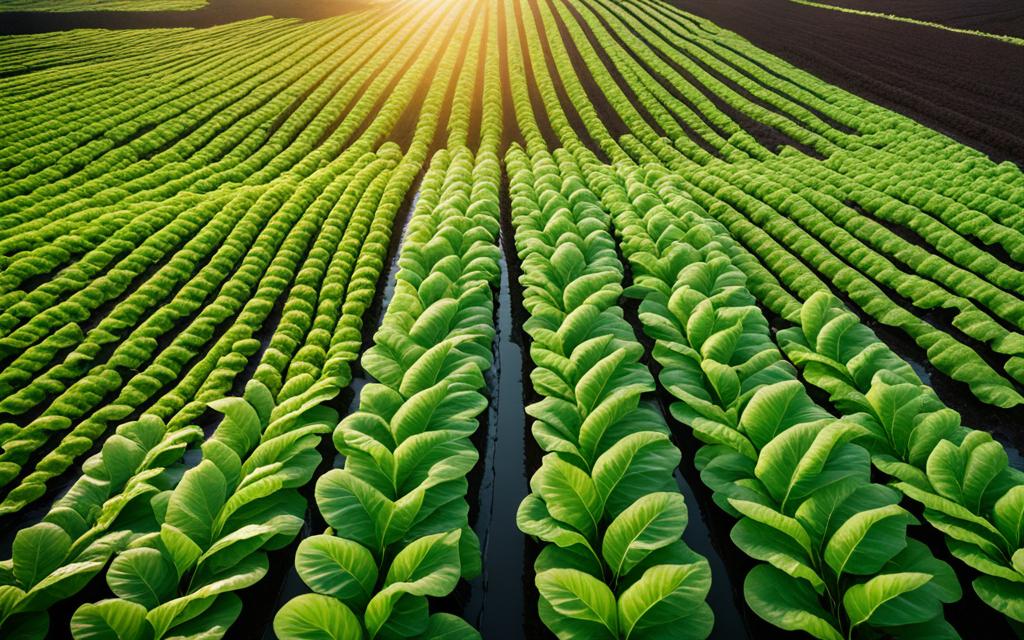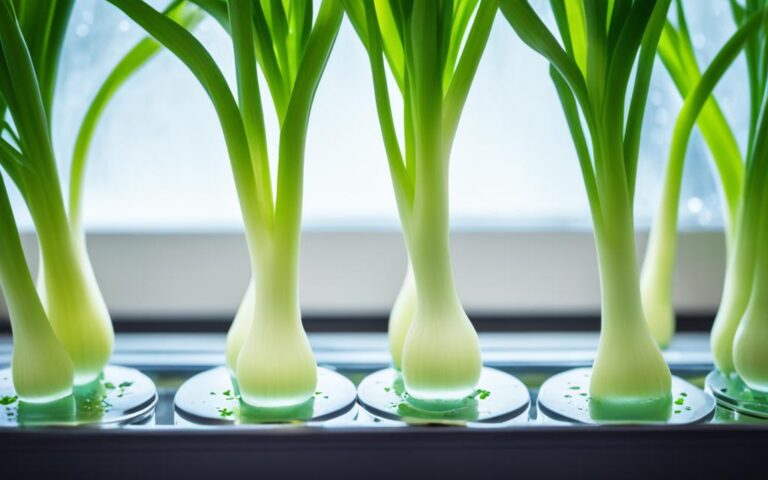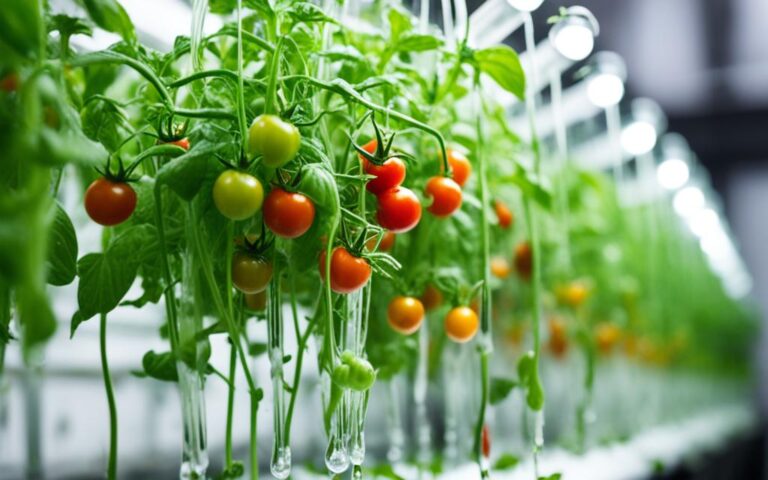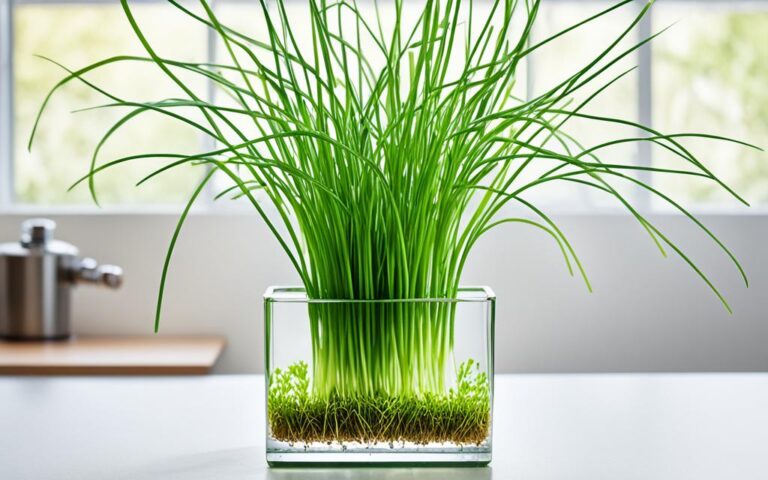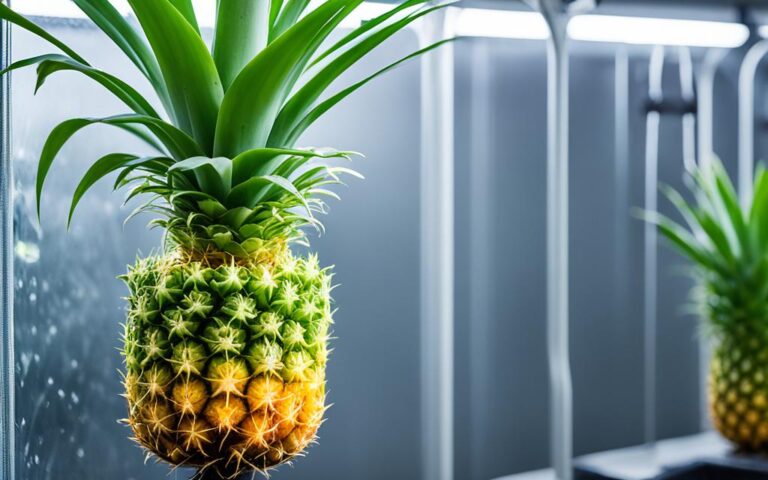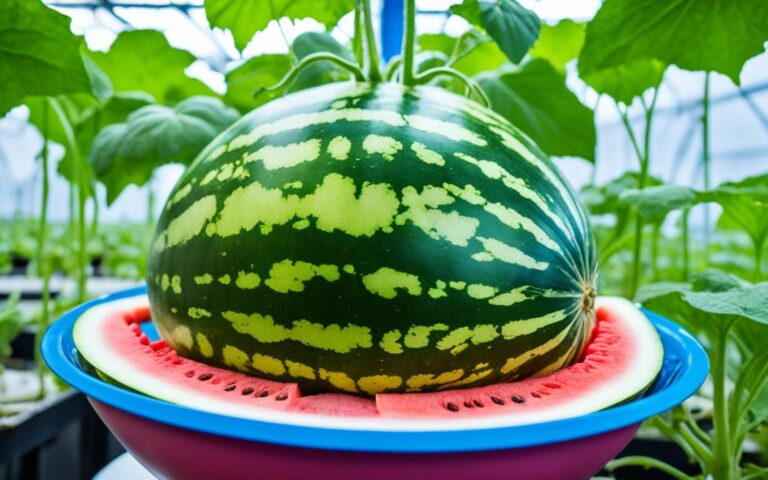Hydroponic Taro: Cultivating A Healthier Future
Did you know taro, a super nutritious root, can grow in hydroponic systems? Hydroponic taro production could change how we grow and eat this versatile crop. It could make our future healthier and more sustainable.
Taro is a key food in many cultures around the world. It’s known for its deep nutritional value. With hydroponics, growers can make the most of this amazing plant. They can get better quality, more produce, and use fewer resources.
Key Takeaways
- Hydroponic taro cultivation offers a sustainable solution for growing this nutritious crop.
- Hydroponic systems can improve taro quality, productivity, and resource efficiency.
- Proper nutrient management, pH control, and pest management are crucial for successful hydroponic taro cultivation.
- Hydroponic taro can meet the growing global demand for this versatile and culturally significant food.
- Adopting hydroponic taro cultivation can contribute to a healthier future by promoting sustainable agricultural practices.
Introduction to Hydroponic Taro Cultivation
In the world of modern farming, hydroponic farming is a game-changer. It grows plants without soil by suspending their roots in a nutrient-rich water solution. This method has many benefits over traditional farming.
What is Hydroponic Farming?
Hydroponic farming grows plants without soil. The roots of the plants are in a nutrient solution instead. This solution gives the plants everything they need to grow well. This method lets farmers control plant growth closely, leading to more food, better quality, and less waste.
Benefits of Growing Taro Hydroponically
- Enhanced nutrient availability and absorption: The nutrient-rich water solution ensures that taro plants have access to all the essential nutrients they require for optimal growth and development.
- Increased water efficiency: Hydroponic systems use up to 90% less water compared to traditional soil-based cultivation, making them an eco-friendly and sustainable option.
- Reduced pest and disease risks: The closed, controlled environment of a hydroponic system minimizes the risk of soil-borne pests and diseases, leading to healthier taro crops.
- Year-round production: Hydroponic systems can be operated indoors, allowing for continuous, climate-controlled taro cultivation throughout the year.
- Space-saving design: Hydroponic systems are highly scalable and can be designed to maximize the use of available space, making them an ideal solution for urban or small-scale farming operations.
By using hydroponic farming, growers can make the most of taro cultivation. This leads to healthier, more sustainable, and productive farming.

Selecting the Right Hydroponic System
Choosing the right hydroponic system for taro is key. Popular options include deep water culture (DWC), nutrient film technique (NFT), and ebb and flow (flood and drain) systems. Each has its pros and cons that growers need to think about for a successful hydroponic taro setup.
Different Hydroponic Systems for Taro
The DWC system is great for taro hydroponics system requirements. It keeps the water steady for the roots. The NFT system moves a thin nutrient-rich solution over the roots for a steady supply of nutrients. The ebb and flow system floods and drains the bed, letting roots breathe and get nutrients.
Factors to Consider When Choosing a System
- Space and layout requirements
- Water and nutrient delivery methods
- Ease of maintenance and monitoring
- Scalability and expansion potential
- Initial investment and ongoing operational costs
Thinking about these points will help growers pick the best hydroponic system for taro. This ensures their setup works well now and in the future.
Best Hydroponic Taro Varieties
Choosing the right taro cultivar for hydroponics is key for great growth and yield. Top hydroponic taro varieties include Maui Lehua, Bun Long, and Po’ulu.
The Maui Lehua is a favorite among hydroponic growers. It’s known for its strong growth and high starch levels. This taro cultivar for hydroponics does well in water-based systems, often producing big, nutritious tubers.
The Bun Long is another top hydroponic taro cultivar. It has a unique taste and grows compactly, perfect for small hydroponic setups. Bun Long taro is loved for its cooking versatility and high nutrient content.
The Po’ulu variety stands out in best taro varieties for hydroponics. It’s known for its toughness, flexibility, and high yield. This makes it a dependable choice for hydroponic taro growers.
“Choosing the right hydroponic taro cultivars is essential for unlocking the full potential of your taro growing operation.”
When picking the best taro varieties for hydroponics, think about growth speed, nutrient use, and system fit. By picking the right taro cultivars for hydroponics, you can boost your harvest and enjoy the perks of growing your own nutritious taro.
Setting Up Your Hydroponic Taro System
Starting a hydroponic taro system is both rewarding and challenging. It’s perfect for both new and experienced gardeners. We’ll show you how to set it up with the right equipment and supplies.
Step-by-Step Guide to Setting Up
- Pick the best hydroponic system for your space, budget, and growth rate needs.
- Get the growing media ready. Make sure it’s clean and right for taro’s needs.
- Put in the equipment like grow lights, air pumps, and irrigation systems for the best taro growth.
- Keep an eye on the pH and nutrient levels in the water for healthy taro plants.
- Keep the system clean to stop algae and other problems that harm taro.
Essential Equipment and Supplies
- Growing Tray or Container: Use a strong, safe container or tray for the growing medium and taro.
- Growing Medium: Choose a soilless medium like coco coir, perlite, or rockwool for taro roots.
- Water Pump and Tubing: These are for moving nutrient water to the taro plants.
- Air Pump and Airstones: They help keep the water oxygenated for healthy roots.
- Grow Lights: You might need extra light for taro, depending on your setup.
- pH and TDS Meters: These tools help keep the water’s pH and TDS levels right.
With the right equipment and supplies and a step-by-step plan, you can create a great hydroponic taro system. This will give you a big harvest and healthier taro for the future.
Nutrient Management for Hydroponic Taro
Cultivating hydroponic taro needs careful nutrient management for the best growth. Taro plants do well with a mix of essential nutrients. These nutrients are key for their health and how well they produce.
Essential Nutrients for Taro Growth
Taro plants need many nutrients to grow well in hydroponics. The main nutrients they need are nitrogen (N), phosphorus (P), and potassium (K). These help with photosynthesis, root growth, and keeping the plant strong.
They also need micronutrients like calcium, magnesium, sulfur, iron, boron, copper, manganese, and zinc. These help with enzyme work, making chlorophyll, and keeping the plants strong.
Preparing Nutrient Solutions
Creating the right nutrient solution is key for taro hydroponics. Growers must mix the nutrients carefully to make a solution that meets the taro’s needs.
By keeping an eye on and adjusting the nutrients, growers can make sure their taro plants get what they need. This leads to strong growth, healthy leaves, and lots of produce.
| Nutrient | Function | Optimum Range for Taro |
|---|---|---|
| Nitrogen (N) | Foliage growth, chlorophyll production | 100-200 ppm |
| Phosphorus (P) | Root development, flowering, and fruiting | 40-80 ppm |
| Potassium (K) | Enzyme activation, disease resistance | 150-250 ppm |
| Calcium (Ca) | Cell wall structure, root growth | 80-120 ppm |
| Magnesium (Mg) | Chlorophyll production, enzyme function | 30-50 ppm |
Maintaining Optimal pH and TDS Levels
Keeping the right pH and TDS levels is key for taro plants in hydroponics. The ideal pH for taro is between 5.5 and 6.5. This range helps the plants get the nutrients they need.
It’s important to check and adjust the pH often. If the levels are off, it can cause problems like nutrient shortages or too much of something harmful. To fix this, growers use pH up or pH down solutions. They can also use pH testing kits or meters to check the levels.
Keeping the TDS right is also crucial. TDS stands for total dissolved solids, which are all the minerals and nutrients in the water. For taro, the best TDS range is 800 to 1200 parts per million (ppm). A TDS meter can help growers keep these levels in check.
| Parameter | Optimal Range |
|---|---|
| pH | 5.5 – 6.5 |
| TDS | 800 – 1200 ppm |
By watching and adjusting the pH and TDS, growers can make sure their taro plants get the best water. This helps with nutrient uptake and keeps the plants healthy. Paying attention to these details is key for a successful hydroponic taro setup.
Light and Temperature Requirements
Cultivating hydroponic taro needs careful attention to its light and temperature needs. Taro grows best in places with lots of light, needing 12-16 hours of light each day. The hydroponic taro light requirements are key for its growth and health.
Grow Light Options for Hydroponic Taro
For grow lights for hydroponic taro, growers have many choices. LED grow lights are a top pick because they’re energy-saving and can be adjusted for taro’s needs. Or, HID lamps like metal halide or high-pressure sodium bulbs also work well, giving the right hydroponic taro temperature and light.
It’s important to match the lighting schedule and strength with the plant’s needs. Taro likes warm, tropical conditions, best at 70-85°F (21-29°C). Keeping these hydroponic taro temperature levels is key for strong growth.
| Lighting Requirement | Optimal Temperature Range |
|---|---|
| 12-16 hours of direct or supplemental lighting per day | 70-85°F (21-29°C) |
By giving the right hydroponic taro light requirements and hydroponic taro temperature, growers can make a great environment for their taro. This ensures a big and healthy harvest.
Hydroponic Taro Nutrients
Growing taro hydroponically needs a fine balance of nutrients for the best growth. Taro plants have special nutrient needs in hydroponics. Knowing the essential nutrients is key to growing healthy taro.
The main nutrients for taro are nitrogen (N), phosphorus (P), and potassium (K). These come from a balanced hydroponic fertilizer. They help with photosynthesis, root growth, and keeping the plant strong.
Taro also needs micronutrients for good growth. These include calcium, magnesium, sulfur, iron, boron, copper, manganese, and zinc. Each micronutrient does something important, like building cell walls or helping enzymes work.
- Nitrogen (N) – Helps with leaf and stem growth.
- Phosphorus (P) – Boosts root growth, flowers, and tubers.
- Potassium (K) – Makes plants strong, helps them survive droughts, and fight diseases.
- Calcium (Ca) – Makes cell walls strong and helps roots grow.
- Magnesium (Mg) – Important for making chlorophyll and photosynthesis.
Knowing what nutrients hydroponic taro needs is crucial for a successful crop. It’s important to understand the taro hydroponic nutrient requirements and the right hydroponic taro fertilizer mix.
Pests and Disease Management
Keeping hydroponic taro plants healthy means watching out for pests and diseases. Even with controlled environments, taro can face problems like aphids, spider mites, Pythium root rot, and bacterial infections.
Common Pests and Diseases in Hydroponic Systems
Aphids are a big problem for hydroponic taro. These tiny insects can spread quickly, harming the plant and spreading viruses. Spider mites also thrive in the warm, dry spots of hydroponic setups.
Fungal diseases, like Pythium root rot, can destroy taro crops fast. Bacterial infections, such as bacterial leaf blight, cause ugly lesions and harm plant health.
Preventative Measures and Treatment
- Keep your hydroponic system clean to reduce pests and diseases.
- Check your taro plants often for pests or diseases, and deal with them quickly.
- Use beneficial insects or microbes to fight pests and diseases in a green way.
- Follow best practices for nutrients and environment to keep plants strong.
- If needed, use safe pesticides or fungicides, but always follow the instructions.
By being careful and using a full plan to manage pests and diseases, hydroponic taro growers can keep their crops healthy and productive. This leads to a better future for their plants.
Harvesting and Post-Harvest Handling
Timing is key when picking harvesting hydroponic taro. The plants are ready when the leaves turn yellow and the corms grow big, usually 6-12 months after planting. It’s vital to know the best taro harvest timing to keep the quality high and extend the shelf life.
After picking, handling the taro right is important. Carefully lift the corms from the soil without harming them. Then, wash the taro to get rid of dirt. Let it dry in the air before storing or moving it.
- Harvest taro when leaves begin to yellow and die back, and corms reach desired size (6-12 months after planting)
- Gently lift corms from growing medium, avoiding damage to roots and tubers
- Wash taro to remove debris, then air-dry before storing or transporting
Good post-harvest handling of hydroponic taro keeps the quality up and makes it last longer. By doing things right, growers can keep their taro fresh and tasty for a longer time. This meets consumer needs and boosts the harvest’s value.
“Timing is everything when it comes to harvesting hydroponic taro. Pay close attention to the plant’s growth and maturity, and handle the tubers with care to preserve their quality.”
Maximizing Yield and Productivity
High yields and productivity are key for hydroponic taro growers. By using smart techniques and optimizing factors, growers can boost their taro’s yield and efficiency. Here are some tips to help you increase your taro yield and productivity:
Optimize Nutrient Management
Make sure your taro gets the right nutrients like nitrogen, phosphorus, and potassium at the right times. Check and adjust the nutrient solution often to match the plants’ needs.
Maintain Ideal Environmental Conditions
Give your taro the best temperature, humidity, and light for growth. Keeping these conditions right can greatly improve increasing hydroponic taro yield and maximizing hydroponic taro productivity.
Implement Proper Pruning and Training
- Prune plants often to help them branch out and grow more leaves. This can lead to more tips for high-yielding hydroponic taro.
- Train plants to grow in a way that gets them more light and air. This boosts productivity even more.
Optimize Growing Density
Find the best plant spacing and density to use space well and give each plant enough room to grow. Too many plants in a small space can slow growth and lower yields.
| Factor | Impact on Yield and Productivity |
|---|---|
| Nutrient Management | Right nutrients at the right time can boost taro yield and quality. |
| Environmental Conditions | Best temperature, humidity, and light help plants grow strong and yield more. |
| Pruning and Training | Smart pruning and training increase branching and leaf area for better yields. |
| Growing Density | Right plant spacing makes the most of space and resources. |
Using these tips for high-yielding hydroponic taro, growers can maximize hydroponic taro productivity and increasing hydroponic taro yield. This leads to a more profitable and sustainable taro operation.
Hydroponic Taro: Cultivating A Healthier Future
Using hydroponic tech for taro cultivation is a step towards a healthier and greener future. It cuts down on the harm to the environment and saves resources compared to traditional farming. At the same time, it keeps the taro quality high and full of nutrients.
Hydroponic taro cultivation brings many benefits, such as:
- Improved water efficiency and reduced water usage
- Reduced reliance on chemical fertilizers and pesticides
- Increased control over nutrient delivery and plant growth
- Higher yields and more consistent crop quality
- Year-round production and reduced seasonal variability
These perks make hydroponic taro farming great for hydroponic taro and food security. It tackles the problems of old-school farming and helps make our food supply more sustainable.
| Attribute | Hydroponic Taro Cultivation | Traditional Soil-Based Taro Farming |
|---|---|---|
| Water Usage | Up to 90% less water consumption | High water requirements for irrigation |
| Nutrient Management | Precise control over nutrient delivery | Reliance on soil nutrients and applied fertilizers |
| Yield Potential | Higher yields per square foot | Depends on soil quality and climatic conditions |
| Environmental Impact | Reduced chemical inputs and waste | Potential for soil degradation and runoff |
By choosing the benefits of hydroponic taro cultivation, farmers can help create a more sustainable taro production system. This supports hydroponic taro and food security in their communities. The future of taro looks bright with the use of hydroponic tech.
Troubleshooting Common Issues
Hydroponic taro farming can face challenges, but knowing how to fix them makes a big difference. Growers often run into issues like nutrient imbalances or pests. Let’s look at the main problems and how to solve them for a healthy hydroponic taro system.
Nutrient Deficiencies and Imbalances
Getting the right nutrients is key for hydroponic taro plants to grow well. Signs like yellow leaves or slow growth might mean the plants lack nutrients. To fix this, check the nutrient solution often and adjust it as needed.
pH and TDS Fluctuations
Keeping the right pH and TDS levels is important for hydroponic taro. If these levels change, it can harm the plants. By watching and adjusting these levels, growers can help their taro plants grow strong and healthy.
Pest and Disease Infestations
Hydroponic taro can get pests like aphids or diseases like fungal infections. These problems can hurt plant health and reduce yields. To fight these issues, growers should check their plants often and use safe pest control methods.
| Issue | Possible Causes | Troubleshooting Solutions |
|---|---|---|
| Nutrient Deficiencies | Imbalanced nutrient solution, insufficient nutrient supply | Test and adjust nutrient solution, increase nutrient concentrations |
| pH and TDS Fluctuations | Improper water pH, changes in water quality, nutrient buildup | Monitor and adjust pH, replace nutrient solution, clean system components |
| Pest and Disease Infestations | Unsanitary conditions, poor air circulation, environmental stress | Implement integrated pest management, improve hygiene and air flow, maintain optimal growing conditions |
By solving these common problems, growers can keep their hydroponic taro systems healthy and productive. Remember, fixing issues with hydroponic taro needs a proactive and flexible approach. Each growing setup is different, so be ready to adapt.
Conclusion
Hydroponic taro cultivation is a new way to grow this nutritious crop that’s better for our planet. It uses water instead of soil, which saves resources and helps the environment. This method also makes the taro taste better and grow faster than traditional farming.
As more people want taro, growing it hydroponically is a smart choice. It lets farmers control exactly what the plants get, like nutrients and water. This means more food, healthier plants, and less harm to the earth.
By using hydroponic taro, we can make our food system better. Growers and experts can work together to make a future that’s good for everyone. The future looks bright for hydroponic taro, offering a chance for a healthier and wealthier world.
